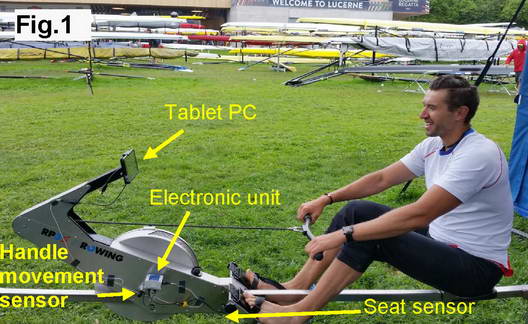The BioRow‚ĄĘ Catch Training System

The new BioRow‚ĄĘ Catch Training System (BRCTS) has been recently developed, and was presented at the World Cup Regatta in Lucerne (Fig.1). The system is a new tool for quick and easy learning and stabilisation of an effective catch technique and proper rowing style. The best way to use the system is to install it on an RP3 rowing machine, which is the closest simulator of a rowing boat, although the BRCTS could be also used on a Concept2 erg, as well as in a boat (with a different handle sensor).

The system is quite simple and consists of a
small electronic unit connected to a tablet PC running the BioRow‚ĄĘ software,
and only two sensors:
·
A handle
movement sensor, which is mounted on the shaft of the flywheel;
·
A seat
displacement sensor, which is mounted on the frame and connected to the seat
with a wire.
The software calculates and displays the two
main factors for every stroke for immediate feedback:
CATCH FACTOR (CF) ‚Äď is the time difference between the moments of changing direction at the handle and the seat at the catch (RBN 2015/09). The most optimal CF was found in the range of -15 to -35ms, which means the seat changes direction earlier than the handle by this time period. More significant negative numbers mean the legs are engaged too early, which may lead to ‚Äėslide shooting‚Äô and wasting work done by the legs. Higher positive numbers mean the seat is engaged too late, which leads to a less dynamic drive and an insufficient ‚Äúuse of weight‚ÄĚ.ROWING STYLE FACTOR (RSF) ‚Äď is the ratio of the seat and handle travels during the first 20% of the drive (about 30cm from the catch). At the most optimal rowing style, this factor should be from 85% to 100%. Numbers higher than 100% indicate ‚Äėslide shooting‚Äô ‚Äďwhere the seat travels further than the handle. Lower numbers mean the trunk is opened up too early, which is also ineffective.
Fig.2 shows a screenshot of the software at work. The user should keep the two indicators at the left of the screen in the green target area. At the bottom-left, some additional variables are shown: stroke length, seat travel and the maximal velocities of the handle and seat. The right part of the screen is used for the curves of the handle and seat velocities.

What should a rower do to achieve the optimal values needed? The catch should begin with a quick acceleration of the seat, initiated by a sharp kick through the toes to the stretcher (Fig.3, 1). Simultaneously, the rower should continue ‚Äėthrowing the handle away‚Äô to the stern for a short time and then ‚Äėhang‚Äô onto it (2). At the catch, the handle and seat velocities are close to zero, so the distances travelled by them during this quick counter-movement are small: only 1-2cm. However, this is enough to accelerate the rower‚Äôs mass and engage it for effective power production. Also, this counter-movement eliminates backlashes in joints, stretches the rower‚Äôs body and prepares it for a better force transmission during the drive. Attempting to ‚Äúpull the handle before pushing the stretcher‚ÄĚ at the catch increases CF and makes it positive (in the red area on the right). An excessive counter-movement and backlash in the rower‚Äôs body makes the CF more negative and the indicator moves to the left blue area.

After the catch, the rower should focus on the
acceleration of the middle of the trunk (at the level of the belly button,
where the CM is located at this time), while ‚Äėhanging‚Äô off the handle by keeping the arms straight and the trunk
angle nearly constant (3). This movement should be provided by the knee extender muscles
(quadriceps) until the knee angle is at 90¬į and the heels are placed on the
foot-board (4). Afterwards, the hip extender muscles (gluts and hamstrings)
should be engaged. Early ‚Äėopening‚Äô of the trunk or ‚Äėgrabbing‚Äô of the arms and
shoulders makes RSF lower and moves its indicator to the red area. A too fast
leg extension and a ‚Äėsoft‚Äô trunk (‚Äúslide shooting‚ÄĚ) increases the RSF number above
100% and moves the indicator to the blue area.



